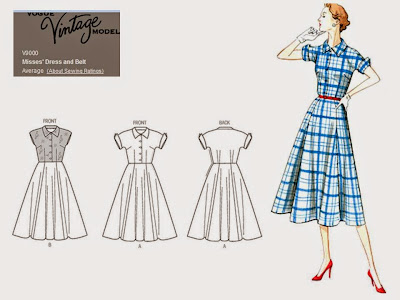Home
▼
Wednesday, July 2, 2014
Teach Yourself to Sew with Vintage Style Patterns
Learning to sew own your own can be fun when you work with patterns that fit your level of sewing skills. If you love vintage and retro styles, then carefully selecting vintage patterns can help to create new ‘vintage style’ looks. But authentic vintage pattern may be difficult to find in the right size, and often they need some alterations for a more modern fit.
Probably the easiest true vintage pattern group to look for are Simplicity sewing patterns from the 1960's forward with a "How to Sew" banner. These patterns have instructions that show details on sewing specific techniques. Often they were designed to be used in traditional home ec. classrooms, so the styles have few pattern pieces and involve simple or entry level sewing techniques.
Starting with a new pattern that is a modern copy of a vintage pattern is a short cut to getting that retro look you want to sew. Learning to sew means that the styles you choose shouldn’t be difficult for someone with beginning sewing skills. The blouses shown above are excellent examples of styles that have easy to sew design elements and limited techniques required.
If you want to sew a blouse or dress with buttons and button holes, prepare by doing some research in sewing books or online so that you understand how buttonholes are located. You may need to consult your sewing machine manual to learn how your machine settings can make those buttonholes for you.
I feature here two styles that have short kimono sleeves, making the bodices easier to sew since set-in sleeves are not required. The patterns in this post are just a small selection of retro or vintage style sewing patterns currently available through the major pattern companies. These patterns were selected for their very basic level of design, limited pattern pieces, simple darts, facings and ease of fit. Using vintage prints or stripes, cute retro styles are possible using these sewing patterns. Some of the patterns do require an entry level skill in fitting, so be sure if you are very new to sewing that you select a style with a looser fit.
Even dresses are possible, just seek out styles that have few pieces and can be easily fit to your size if that is required. Usually dresses have zippers, so that technique may be your main challenge in sewing a dress.
When looking further at sewing patterns, read the list below so that you have a good idea what sewing projects may be at your skill level. You might want to avoid the more advanced level projects, since those techniques or design elements may be too difficult to sew right now.
Level ONE: You are a new sewist, and need patterns that aren’t difficult or complicated. Look for:
Few pattern pieces
Loose fit “A” line shapes on dress or skirt
2 dart front: side seam darts or French darts
Sleeveles and collarless blouses or bodices
Wrap skirts (no zipper)
No waistband on skirt
Back zipper (no side or underarm zippers), with one side overlap (not centered)
Patch pockets
Fabrics that are stable, smooth and easy to cut, sew and press, such as light weight quilting cottons, woven stripes and plaids in cotton.
Level TWO: You have started sewing fashions and are ready to try some patterns that are a bit more difficult. You are ready for some of the more easy challenges in fitting patterns too. Look for:
Sheath dress: a more fitted one piece dress with 2 or 4 darts in front, 2 darts in back
Princess seamline dress: more fitted one piece dress with shaped vertical seamlines from underarm to hem, both front and back
Fitted bodice with darts in front (not tight fitting)
Fitted bodice with princess seamlines in front (not tight fitting)
Plain sleeves (no cuffs)
Sleeves with gathered shoulder or puff sleeves
Waistband on skirt
Side seam pocket
Loose pajama pants or elastic waist pants
Collar sewn in a dress neckline
Men’s bowling or Hawaiian style shirt (small collar, no back yoke, short sleeves)
Invisible zipper: hard to understand, easy to sew
Fabrics: add soft cottons or rayons to your selection, also consider embroidered fabrics and border prints
Level THREE: If you have been sewing for awhile, then projects that require good sewing techniques, fabric control and fitting are nice to work on. Look for:
Close fitting one piece dress with darts or princess seamlines
Close fitting bodice with 4 darts in front or princess seamlines, has skirt sewn to bodice at waistline
Collar on blouse, convertible collar
Straight skirt, fitted with darts or princess seam lines
Dress with a waistline seam
Buttons and buttonholes
Pants with waistband or yoke, back or size zipper
Fabrics: wool flannel, velvet and velveteen and denim have the level difficulty that would be good to try sewing
Level FOUR: These projects are for the sewist who is ready to sew just about any style. Fitting and complicated techniques in sewing should be great for this skill level
Sleeves with cuffs
Men’s style shirt collars
Men’s style shirt with back yoke
Fly Front zippers on pant or skirt
Side zipper on dress with sleeves
Fitted bodices such as corsets and formal wear.
Difficult fabrics that might be slippery, thick or hard to work with.
In my next post, I'll go over a few sewing resources to help you problem solve and learn new techniques.








